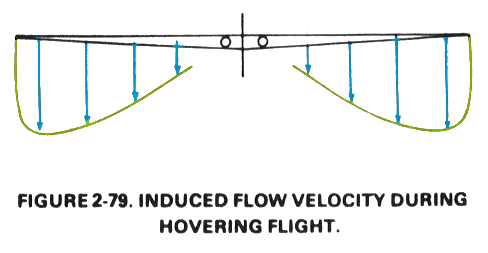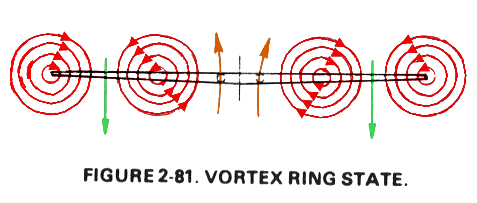
Conditions conducive to settling with power are a vertical or nearly vertical descent of at least 300 feet per minute and low forward airspeed. The rotor system must also be using some of the available engine power (from 20 to 100 percent) with insufficient power available to retard the sink rate. These conditions occur during approaches with a tailwind or during formation approaches when some aircraft are flying in turbulence from other aircraft.
Under the conditions described above, the helicopter may descend at a high rate which exceeds the normal downward induced flow rate of the inner blade sections. As a result, the airflow of the inner blade sections is upward relative to the disk. This produces a secondary vortex ring in addition to the normal tip vortex system. The secondary vortex ring is generated about the point on the blade where airflow changes from up to down. The result is an unsteady turbulent flow over a large area of the disk which causes loss of rotor efficiency even though power is still supplied from the engine.
This figure shows the induced flow along the blade span during normal hovering flight:

Downward velocity is highest at the blade tip where blade airspeed is highest. As blade airspeed decreases nearer the disk center, downward velocity is less. This figure shows the induced airflow velocity pattern along the blade span during a descent conducive to settling with power:

The descent is so rapid that induced flow at the inner portion of the blades is upward rather than downward. The upflow caused by the descent has overcome the downflow produced by blade rotation. If the helicopter descends under these conditions, with insufficient power to slow or stop the descent, it will enter the vortex ring state:

During the vortex ring state, roughness and loss of control is experienced because of the turbulent rotational flow on the blades and the unsteady shifting of the flow along the blade span.
This figure shows the relationship of horizontal speed versus vertical speed for a typical helicopter in a descent. Straight lines emanating from the upper left corner are lines of constant descent angle. Superimposed on this grid are flow state regions for the typical helicopter. From this illustration, several conclusions regarding the vortex ring state can be drawn:

Normal tendency is for pilots to recover from a descent by application of collective pitch and power. If insufficient power is available for recovery, this action may aggravate power settling resulting in more turbulence and a higher rate of descent. Recovery can be accomplished by lowering collective pitch and increasing forward speed. Both of these methods of recovery require altitude to be successful.